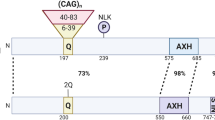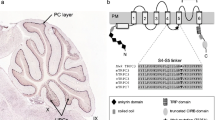Abstract
The dominantly inherited cerebellar ataxias are a clinically and genetically heterogeneous group of neurodegenerative disorders. Studies using mouse models as well as recent genetic and transcriptomic human findings point to an important role for TRPC3 signaling in cerebellar ataxia.

Similar content being viewed by others
References
Bettencourt C, Ryten M, Forabosco P, Schorge S, Hersheson J, Hardy J, et al. Insights from cerebellar transcriptomic analysis into the pathogenesis of ataxia. JAMA Neurol. 2014;71:831–9.
Becker EBE. The moonwalker mouse: new insights into TRPC3 function, cerebellar development, and ataxia. Cerebellum. 2014;13:628–36.
Hartmann J, Dragicevic E, Adelsberger H, Henning HA, Sumser M, Abramowitz J, et al. TRPC3 channels are required for synaptic transmission and motor coordination. Neuron. 2008;59:392–8.
Kim SJ. TRPC3 channel underlies cerebellar long-term depression. Cerebellum. 2013;12:334–7.
Zhou H, Lin Z, Voges K, Ju C, Gao Z, Bosman LW, et al. Cerebellar modules operate at different frequencies. Elife. 2014;3:e02536.
Becker EBE, Oliver PL, Glitsch MD, Banks GT, Achilli F, Hardy A, et al. A point mutation in TRPC3 causes abnormal Purkinje cell development and cerebellar ataxia in moonwalker mice. Proc Natl Acad Sci U S A. 2009;106:6706–11.
Metzger F. Molecular and cellular control of dendrite maturation during brain development. Curr Mol Pharmacol. 2010;3:1–11.
Becker EBE, Fogel BL, Rajakulendran S, Dulneva A, Hanna MG, Perlman SL, et al. Candidate screening of the TRPC3 gene in cerebellar ataxia. Cerebellum. 2011;10:196–9.
Németh AH, Kwasniewska AC, Lise S, Schnekenberg RP, Becker EBE, Bera KD, et al. Next generation sequencing for molecular diagnosis of neurological disorders using ataxias as a model. Brain. 2013;136:3106–18.
Fogel BL, Hanson SM, Becker EBE. Do mutations in the murine ataxia gene TRPC3 cause cerebellar ataxia in humans? Mov Disord. 2015;30:284–6.
Conflict of Interest
The author declares no conflict of interest.
Author information
Authors and Affiliations
Corresponding author
Rights and permissions
About this article
Cite this article
Becker, E.B.E. From Mice to Men: TRPC3 in Cerebellar Ataxia. Cerebellum 16, 877–879 (2017). https://doi.org/10.1007/s12311-015-0663-y
Published:
Issue Date:
DOI: https://doi.org/10.1007/s12311-015-0663-y




